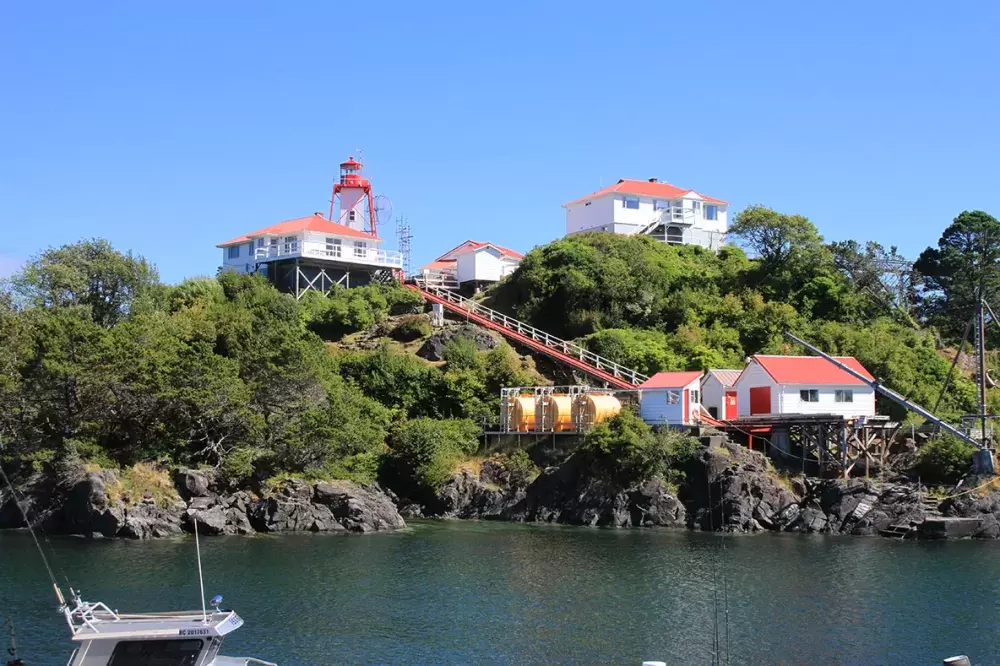Elders, cultural observers and archeologists gathered this summer on remote San Rafael Island at Yuquot after ancestral remains were discovered at Nootka Lightstation.
Remains of a woman, radiocarbon dated to approximately 1,000 years ago, were found in 2017 through an archeological assessment required before major upgrading could be undertaken at the light station. Since then, additional remains believed to be those of an adolescent have also been recovered.
Yuquot or Friendly Cove, the centre of the Nuu-chah-nulth world and the location of first contact, was once a summer home to the Mowachaht/Muchalaht people going back at least 4,000 years. The village once stood about 200 metres from where remains were found.
“To the Mowachaht/Muchalaht people, it is very important to have our cultural monitors on site when there is a disturbance to the ground,” explained Anthony Dick, MMFN elder. “This site means a lot to our people; we had mortuary displays here to commemorate our lost loved ones.”
Originally constructed in 1911, the light station serves as a beacon for mariners and as a seasonal inshore rescue boat station. Two lighthouse keepers reside there year-round. Fisheries and Oceans Canada and the Canadian Coast Guard (DFO/CCG) are completing construction and repair work to the station, working in partnership with MMFN.
The ancestral remains were found in a garden near the lighthouse. They are believed to be those of a female aged 35-44. As a result of the find last summer, construction was put on hold to further assess the area and more soil screening was done this August.
Ray Williams and his wife Terry are among the few remaining MMFN members residing at Yuquot. Even with their extensive knowledge of the area, they weren’t expecting remains to be found on the island. Grave sites would be inconsistent with Nuu-chah-nulth customs at the time.
“In those days, there was no such thing as burying people underground,” Williams said. “That came after the church arrived. People were buried high up on a rock, high in a tree. Elders were buried underneath a canoe and children in a blanket in a shallow grave.”
This led Williams to offer his own theory about how the remains were deposited.
“I’m suspecting that they were picked up and dropped there by the tsunami that came 300 or 400 years ago, but that’s just a real guessing game,” he said.
Supporting this possibility, the location of the remains was about the same height as his house, roughly 20 metres above sea level.
Another puzzling discovery at the site — blue Russian trade beads — is also inconsistent with traditional practices, Williams observed. Such beads were foreign to Nuu-chah-nulth culture before trading with Europeans began about 300 years ago.
Williams pointed out that a previous scientific survey on the impact of the 1700 tsunami found minerals from the sea deposited on a nearby lake bottom, confirming the local impact of giant waves. The evidence corroborates Nuu-chah-nulth oral history, which recalls a catastrophic loss of life among west coast villages from that disaster 318 years ago.
DFO/CCG hired Aquilla Archeology, a Nanaimo-based consultancy with an extensive track record of working at remote marine sites in partnership with First Nations along the southern B.C. coast. Aquilla has ensured all remains were recovered with a view to ensuring a proper burial could be performed. Over the past month, they uncovered more remains of the first individual as well as those of a second person, now identified as an adolescent.
MMFN cultural observers and elders have been crucial to ensuring proper respect to the land, DFO/CCG noted.
“It is important that we be respectful to our ancestors,” Anthony Dick said. “Our rich cultural beliefs are still practiced today. The coast guard understands our concerns and have helped us to carry out our duties as cultural monitors.”
This marks a profound shift since the light station was first built. The deal struck at that time gave the Canadian government permission to construct a lighthouse on San Rafael Island in exchange for a bull and two cows. That structure was replaced in 1958 with a new lighthouse and an array of other buildings have been added since then, exceeding terms of the original agreement.
“All this time it’s been under our noses,” Ray said, adding that the MMFN Chiefs Council is working on the matter.
Pacific Industrial Marine (PIM) is the general contractor completing the work, and over the next few months, construction crews and heavy equipment will be working at the site.
Work at the site includes repairs to a derrick landing, replacement of the rescue boat float, repair of a tramway and addition of an access stairway. PIM will also be repairing an old breakwater to better protect Friendly Cove.
There will also be a third-party environmental monitor on site throughout construction. If all goes as planned, the upgrades will be completed this fall with the Inshore Rescue Boat Service scheduled to return to Nootka Lightstation next summer.







